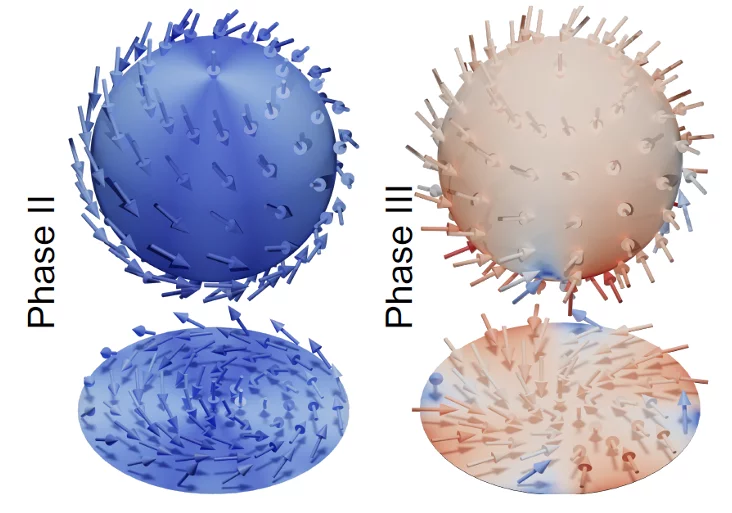Magnetic skyrmions, with their distinctive vortex-like magnetic spin configurations, continue to intrigue researchers due to their potential applications in nanoscience and technology. Traditionally skyrmions form two-dimensional hexagonal close-packed lattices, with the skyrmions themselves displaying one of just two types of internal magnetization texture known as Bloch- or Néel-type. Recent theories hinted at the prospect of reconfigurable transitions between skyrmion phases of different lattice types and internal textures. Until now, experimental evidence supporting such theories has been scarce.
New research led by the Laboratory for Neutron Scattering and Imaging (LNS) at PSI has discovered the polar tetragonal magnet EuNiGe3 to host two so-called hybrid skyrmion phases, each exhibiting unique internal textures characterized by different combination different of Bloch- and Néel-type windings. A particular novelty of the results is the direct transition between the two phases, triggered by the variation of a magnetic field, which coincides with a hexagonal-to-square skyrmion lattice transformation. From a comprehensive theoretical analysis, this remarkable metamorphosis of skyrmion phases is suggested to arise from the competition between different types of magnetic interactions in the material. A second key aspect is precisely how the magnetic skyrmion lattices orient themselves inside the host crystal lattice. This latter part is crucial, since in EuNiGe3 the skyrmion lattices happen to align with reduced symmetry directions. Within the theory, this successfully facilitates a competition of interactions promoting both Bloch- and Néel-type textures simultaneously, thus leading to the new hybrid spin textures.
This research not only provides insights for understanding why experimental evidence for skyrmion lattice transitions is scarce, but it also introduces a strategy for realizing hybrid skyrmion formation in bulk materials. The breakthroughs further have profound implications for the exploration and control of topological magnetic phases, as well providing platforms for exploring potential technological applications, such as reconfigurable skyrmion-based magnonic crystals.
The research was performed in collaboration with researchers from PSI’s Laboratory for Multiscale materials experiments (LMX), University of Tokyo, Hokkaido University, RIKEN Center for Emergent Matter Science, Helmholtz-Zentrum Berlin and the Insitut Laue-Langevin.
Facility: SINQ
Reference: D. Singh et al, Nature Communications 14, 8050 (2023)
Read full article: here


